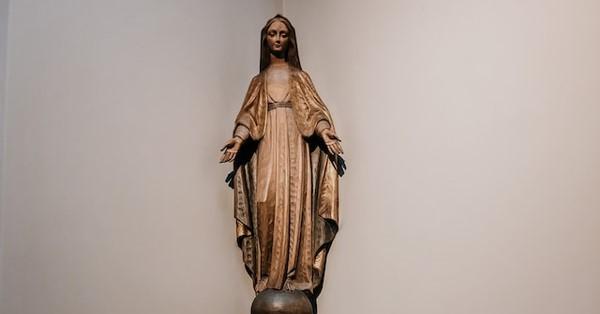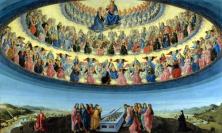What do the texts that we hear and speak during a liturgy reveal to us when we are fully attentive to them? Christopher Brolly SJ uses the Mass prayers, readings and Liturgy of Hours for the solemnity of the Assumption (15 August) to explain the theology of what we celebrate with this feast.
Glorious things are spoken of you, O Mary, who today were exalted above the choirs of Angels into eternal triumph with Christ.[1]
The entrance antiphon for the vigil of the solemnity of the Assumption of the Blessed Virgin Mary encapsulates three overarching theological themes from the very beginning of our celebration of the event we remember on 15 August each year. Firstly, by mentioning both Jesus and his mother in the same opening proclamation, it reveals the life of Mary to be inextricably linked to that of Christ and his saving work. Secondly, the entrance antiphon announces the ‘glorious… exalted… triumph’ that Catholics gather to celebrate on this day by remembering Mary’s Assumption into heaven. Thirdly, the antiphon does not merely dwell in anamnesis of Mary’s Assumption – it invites the assembly gathered in celebration to a response with the statement ‘Glorious things are spoken of you, O Mary’, challenging Catholics from the beginning of the liturgy to reflect on the place they give in their spiritual life to the Blessed Virgin Mary.
Early Christian communities certainly responded to this call and spoke glorious things of Mary from the beginning of Christianity: by 650, 15 August had been set aside both in the Eastern Roman Empire and in the Roman Catholic Church for the celebration of Mary’s passing away (koimesis in Greek, dormitio in Latin).[2] The officialising of this solemnity grew out of a tradition of popular devotion to the dormition of Mary, notably in Jerusalem where there was ‘a vast apocryphal literature on the transitus of Mary’ and a possible ‘tomb of Mary’ was venerated in the basilica of Gethsemane in the fifth century.[3] As liturgical commemoration of Mary’s passage through death to life in heaven was constant over so many centuries, the Assumption of the Blessed Virgin Mary was declared integral to the Church’s self-understanding by Pope Pius XII in 1950.
The life of Mary as inseparably linked to that of Christ and his saving work
Mariology rooted in Christology
The Second Vatican Council’s Constitution on the Sacred Liturgy, Sacrosanctum concilium, makes an essential point about the place of Mary in the liturgy: ‘she is inseparably linked with her son’s saving work’.[4] Ignazio Calabuig builds on this, explaining that, ‘the liturgical veneration of the Mother of the Lord has value and meaning only if rooted in the Word of God and only if it fits harmoniously into the celebration of the history of salvation’.[5] This fundamental liturgical principle that Mariology always takes place within the context of Christology is absolutely the case in the liturgical texts of the solemnity of the Assumption of the Blessed Virgin Mary. Throughout the texts, Mary’s name is usually accompanied with reference to Christ her son and his saving work. The phrasing of the Collect of the solemnity – which is repeated five times across the Liturgy of the Hours and Masses – orders its reference to Jesus before that of Mary, so as to root our celebration of Mary’s glory in the glory of Christ: ‘your Only Begotten Son was born of her according to the flesh and … she was crowned this day with surpassing glory.’[6]
A rejoicing that points beyond Mary
Repeatedly the texts encourage participants to rejoice at Mary’s Assumption – but this is a rejoicing that has for its true end the worship of Jesus Christ her son. One of the two possible entrance antiphons at the Mass during the day speaks of ‘the Virgin Mary, at whose Assumption the Angels rejoice and praise the Son of God’,[7] while the responsory of Evening Prayer I echoes this construction, stating: ‘as Mary is taken up to heaven, the angels of God rejoice. They worship the Lord and sing his praises.’[8] This same message is, in fact, transmitted to the assembly by Mary herself, in the words of the day’s gospel. ‘My soul proclaims the greatness of the Lord; my spirit rejoices in God my Saviour… the Almighty has done great things for me and holy is his Name.’ [9] Mary demonstrates how we are to celebrate the Assumption: in resembling Elizabeth in our praise of Mary, we must not separate our praise of Mary from our praise of God. In fact, like Mary who magnifies the greatness of God, we too are to turn our attention to the God who is working through her: we rejoice in Mary’s assumption, we worship the God who carries out this saving work in and through her. This same message is also hinted at in the reading at Morning Prayer in which the prophet Isaiah prefigures Mary’s magnificat: ‘I rejoice heartily in the Lord, in my God is the joy of my soul.’[10] St Louis-Marie Grignion de Montfort captures this dynamic succinctly in his affirmation that, ‘Mary is the wonderful echo of God, who answers only “God” when she is called “Mary”, who glorifies only God, when… she is called blessed.’[11]
Shared life, shared salvation
Throughout the solemnity’s liturgical texts, Mary’s maternity is mentioned in the same breath as her Assumption into heaven, creating a recurring mirroring between her original union to Christ on earth and her later union to Christ in heaven. Mary’s motherhood is portrayed as integral to our redemption as we are dismissed from Mass with the solemn blessing: ‘May God, who through the childbearing of the Blessed Virgin Mary willed in his great kindness to redeem the human race, be pleased to enrich you with his blessing.’[12] The rich metaphor comparing Mary – who carried Christ in her own body – to the Ark of the Covenant is used repeatedly[13] in the Liturgy of the Word to foreshadow the future Assumption of Mary into heaven.[14] Through this it is made clear that Mary’s place in heaven is intrinsically connected to the ‘place’ she gave to Christ on earth through her motherhood. This connection is poetically intertwined in the Office of Readings: first of all in the responsory which proclaims that: ‘from your womb, Christ, the Sun of Justice, has risen’;[15] and then in the second reading which cites St John Damascene’s intuition that, ‘it was right that she who had given her Creator, as a child, a place at her breast should be given a place in the dwelling-place of her God.’[16] Therefore we learn that the Assumption is a celebration of the mysterious unity between Mary and Christ, which climaxes in their reunion in heaven.
Celebrating the Assumption
Participating in the paschal mystery
The two great mysteries of the life of Christ, the paschal mystery and the incarnation, are both revealed beneath the surface of the liturgical texts of the solemnity of the Assumption. Pope Pius XII points out that the Assumption commemorates Mary’s ‘triumph over death and her heavenly glory’, and goes on to reiterate that ‘the glorious resurrection of Christ is essential to this victory and its final prize, but the blessed Virgin’s share in that fight must also have ended in the glorification of her body.’[17] One can therefore argue that in celebrating the Assumption, we are celebrating Mary’s share in salvation, her own emulation of the paschal mystery, her own passage from death[18] to eternal life and glorification. To that end, the lectionary is replete with victorious, triumphant imagery. Most evocatively there is the repeated image of ‘a woman clothed with the sun, and the moon beneath her feet, and on her head a crown of twelve stars.’[19] Mary’s victory is part of Christ’s victory. While in the Pauline texts used during the solemnity we read of the triumphant Jesus who has ‘put all his enemies under his feet’,[20] in Revelation 11 we have Mary sharing in the same victorious stance. Tellingly, Mary is standing on the moon,[21] with its night-time connotations of darkness, sin and death, whereas she is clothed with the sun, aligning her with light, life and, ultimately, Christ. Pope St John Paul II drew clear parallels between the Assumption and the paschal mystery, teaching that:
perfectly united with the life and saving work of Jesus, Mary shares his heavenly destiny in body and soul…. The Assumption is therefore the culmination of the struggle which involved Mary’s generous love in the redemption of humanity and is the fruit of her unique sharing in the victory of the cross.[22]
The incarnational dynamic of the Assumption
Throughout the liturgical texts of the solemnity, there is a clear movement from earth to heaven. The Liturgy of the Hours launches us heavenwards: ‘Arise, O Virgin Queen’.[23] The Mass plucks us from earthly obscurity and exalts us to heavenly glory.[24] The gospel announces that ‘he has cast down the mighty from their thrones and has lifted up the lowly.’[25] Father and Spirit worked through Mary to enable Jesus to come from heaven to earth, so now Father, Son and Spirit lift Mary from earth to heaven in this moment of salvation. The initial descending trajectory of the incarnation has now taken on its ascending fulfilment. At the Assumption of the Blessed Virgin Mary, this cycle of salvation completes itself, as humanity is reunited with divinity in heaven and on earth.
Mary, our model of holiness
Mary’s Assumption is our call to conversion
However, the Assumption is not just about the Blessed Virgin Mary’s ascent and bodily resurrection. It is also about our own. Sacrosanctum concilium makes it clear that Mary is a model of holiness for all Christians to follow: ‘In her the Church holds up and admires the most excellent fruit of the redemption, and joyfully contemplates… that which she herself desires and hopes wholly to be.’[26] Pope St John Paul II puts it more poetically [and briefly!] in his declaration that ‘Mary's unique vocation is inseparable from humanity's vocation’.[27] We too have a divine destination and are invited to participate in the same trajectory of salvation first traced by Jesus and subsequently followed by Mary. This theology is asserted clearly in the Preface of the Assumption, where it is prayed:
For today the Virgin Mother of God was assumed into heaven as the beginning and image of your Church’s coming to perfection and a sign of sure hope and comfort to your pilgrim people.[28]
In giving the assembly a foretaste of the fulfilment of God’s project of salvation, the Assumption is an invitation for Christians to emulate Mary in holiness and thus be reunited with God in heaven. Like Mary leaving Elizabeth in the gospel, we are called to ‘return to our home’.[29] This requires a reorientation, a realignment of our lives with heaven. And so, as we depart the eucharist, we are sent out on mission with the solemn blessing to ‘carry away with you the gifts of spiritual joys and heavenly rewards’[30] so that we may live our lives in the hope of glorifying God and experiencing resurrection. Here, the responses to the intercessions of Morning Prayer give a clear indication of what this entails: ‘free us from the corruption of sin… make us temples of your Spirit for ever... help us to fix our thoughts on things above… make us worthy to share this glory.’[31] Therefore we discover that at the heart of the solemnity of the Assumption there is a call to orientate ourselves to our heavenly destination, a call to conversion in our lives, a call to rebuild ourselves based on Mary, our model of holiness. Indeed, ‘where Mary is present, this world begins to participate in its destiny.’[32]
O God, worker of miracles, you made the immaculate Virgin Mary share, body and soul, in your Son's glory in heaven: direct the hearts of your children to that same glory.[33]
Christopher Brolly SJ is a Jesuit in formation, currently studying theology at Boston College School of Theology and Ministry.
[1] Entrance antiphon to the vigil Mass, Roman Missal 2010
[2] Ignazio Calabuig, ‘The Liturgical Cult of Mary in the East and West’, in Handbook for Liturgical Studies, Volume V: Liturgical Time and Space, ed. Anscar Chupungco (Collegeville, MN: Liturgical Press, 2000), pp. 253-4.
[3] Ibid.
[4] Pope Paul VI, Sacrosanctum concilium (4 December 1963) §103: https://www.vatican.va/archive/hist_councils/ii_vatican_council/documents/vat-ii_const_19631204_sacrosanctum-concilium_en.html
[5] Calabuig, ‘The Liturgical Cult of Mary in the East and West’, p. 227.
[6] Collect of the vigil Mass, Roman Missal 2010
[7] Entrance Antiphon 2, Mass during the day, Roman Missal 2010 [emphasis mine].
[8] Responsory, Evening Prayer I, Liturgy of the Hours [emphasis mine].
[9] Gospel of the Mass during the day (Luke 1:39-56).
[10] Reading from Morning Prayer (Isaiah 61:10), Liturgy of the Hours.
[11] Louis-Marie Grignion de Montfort, The Secret of Mary (London: Burns, Oates & Washbourne, 1926), §10 (translated from the original French: ‘Marie est l'écho admirable de Dieu, qui ne répond que « Dieu », lorsqu'on lui crie « Marie », qui ne glorifie que Dieu, lorsque… on l’appelle bienheureuse.’)
[12] Solemn blessing (part 1 of 3), Mass during the day, Roman Missal 2010.
[13] ‘David assembled all Israel in Jerusalem to bring the ark of the LORD to the place which he had prepared for it’ (1 Chronicles 15, first reading of the Vigil Mass); ‘Lord, go up to the place of your rest, you and the ark of your holiness’ (Psalm 132, responsorial psalm of the Vigil Mass); ‘God’s temple in heaven was opened, and the ark of his covenant could be seen in the temple’ (Revelation 11, first reading of the Mass during the day).
[14] Another potentially powerful sentence for the practising Catholic could be the reference in 1 Chronicles: ‘The Levites bore the ark of God on their shoulders with poles’ (1 Chronicles 15), which would surely resonate with communities accustomed to carrying statues of Our Lady in procession at various points of the liturgical year.
[15] Responsory of the Office of Readings, Liturgy of the Hours.
[16] St John Damascene, quoted in From The Apostolic Constitution of Pope Pius XII on the Assumption of the Blessed Virgin Mary, second reading of the Office of Readings, Liturgy of the Hours.
[17] From The Apostolic Constitution of Pope Pius XII on the Assumption of the Blessed Virgin Mary, second reading of the Office of Readings, Liturgy of the Hours.
[18] Mary’s death and subsequent glorification is addressed in the Veneranda prayer of the seventh century Gregorian Formulary (GrH 661), which reads ‘sancta Dei genetrix mortem subiit temporalem nec tamen mortis nexibus deprimi potuit’: Mary underwent death but she could not be vanquished by death. This is another powerful parallel between the Assumption of Mary and the Paschal Mystery of Jesus Christ. (Calabuig, ‘The Liturgical Cult of Mary in the East and West’, p. 262.)
[19] Entrance Antiphon 1 and first reading (Revelation 11:19; 12:1-6), Mass during the day.
[20] An image repeated: firstly in 1 Corinthians 15:20-27, second reading of the Mass during the day, secondly in 1 Corinthians 15:20-27 (‘he subjected everything under his feet’) and then in Ephesians 1:16-2:10 (‘he has put all things under his feet’), first reading of the Office of Readings.
[21] Like the earlier allusion to Marian processions, this is another image that may feel ‘liturgically familiar’ to the practising Catholic, given the widespread presence of statues found in Catholic churches of Our Lady standing on the moon, often with a snake symbolising sin and death under her foot.
[22] Pope John Paul II, ‘General Audience,’ 2 July 1997: https://www.vatican.va/content/john-paul-ii/en/audiences/1997/documents/....
[23] Responsory of Office of Readings, Liturgy of the Hours. Other similar antiphons are: ‘Mary has been taken up to heaven’ (Antiphon 1 of Evening Prayer II).
[24] ‘O God, who, looking on the lowliness of the Blessed Virgin Mary, raised her to this grace’ (Collect repeated five times during the solemnity – Vigil Mass and all Liturgy of the Hours; emphasis mine).
[25] Gospel of the Mass during the day (Luke 1:39-56).
[26] Sacrosanctum concilium, §103
[27] Pope John Paul II, ‘General Audience’, 24 January 1996.
[28] Preface from the Mass during the day, Roman Missal 2010.
[29] ‘Mary remained with her about three months and then returned to her home’ (Luke 1:39-56). Gospel from the Mass during the day.
[30] Third part of the Solemn Blessing of the Mass during the day, Roman Missal 2010.
[31] Intercessions from Morning Prayer, Liturgy of the Hours.
[32] Monsignor Lorenzo Albacete, source unknown.
[33] Intercessions from Evening Prayer I, Liturgy of the Hours.





